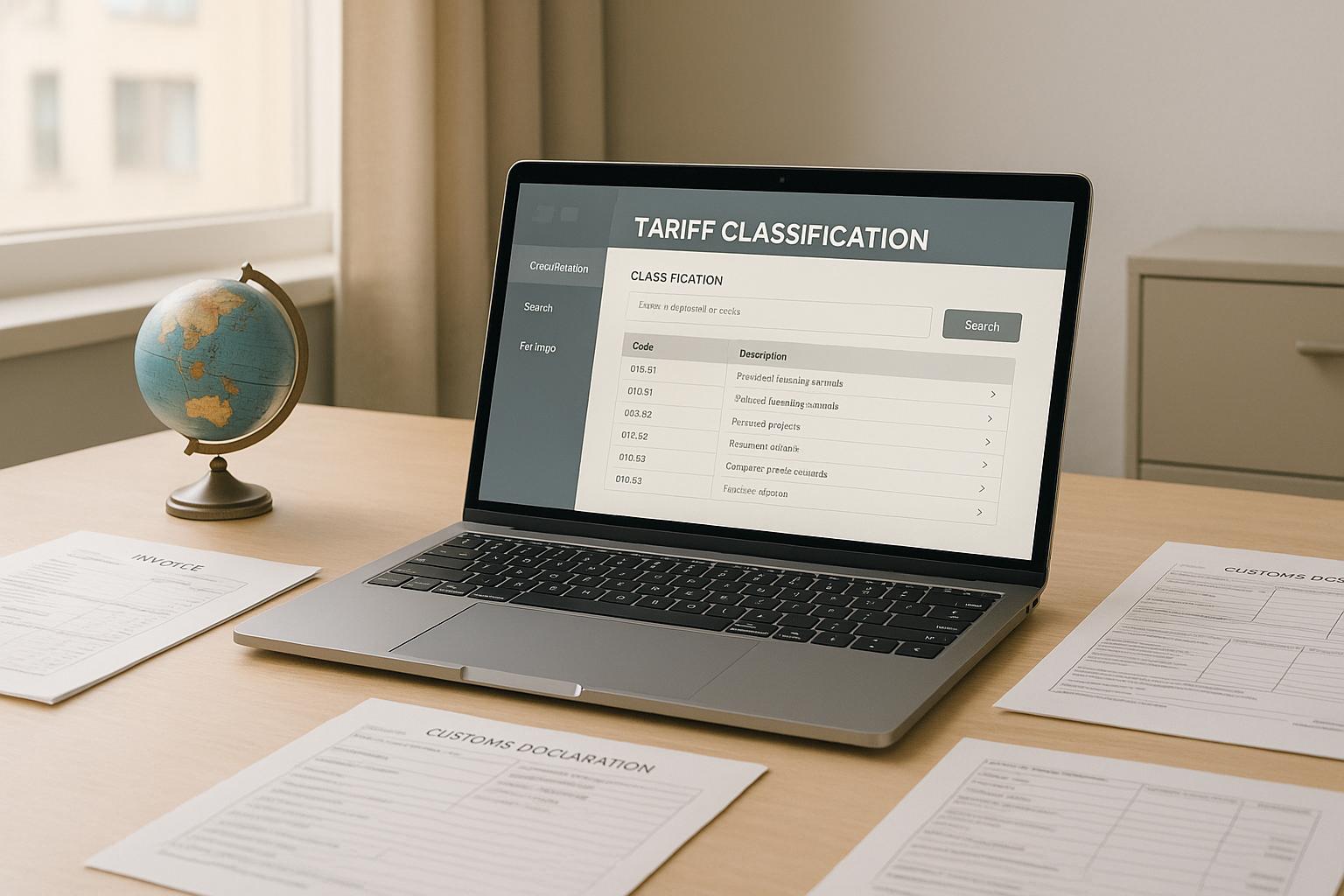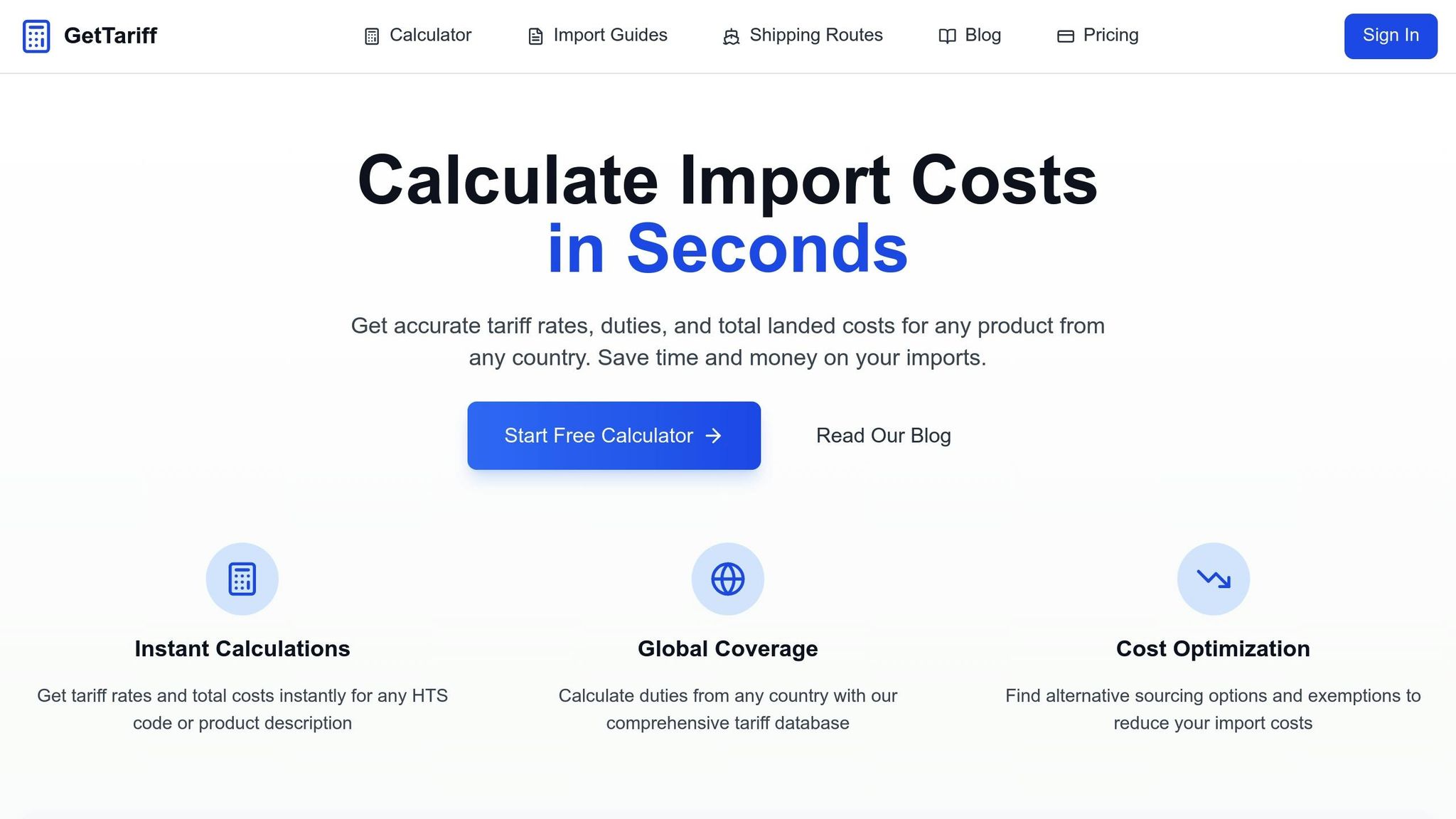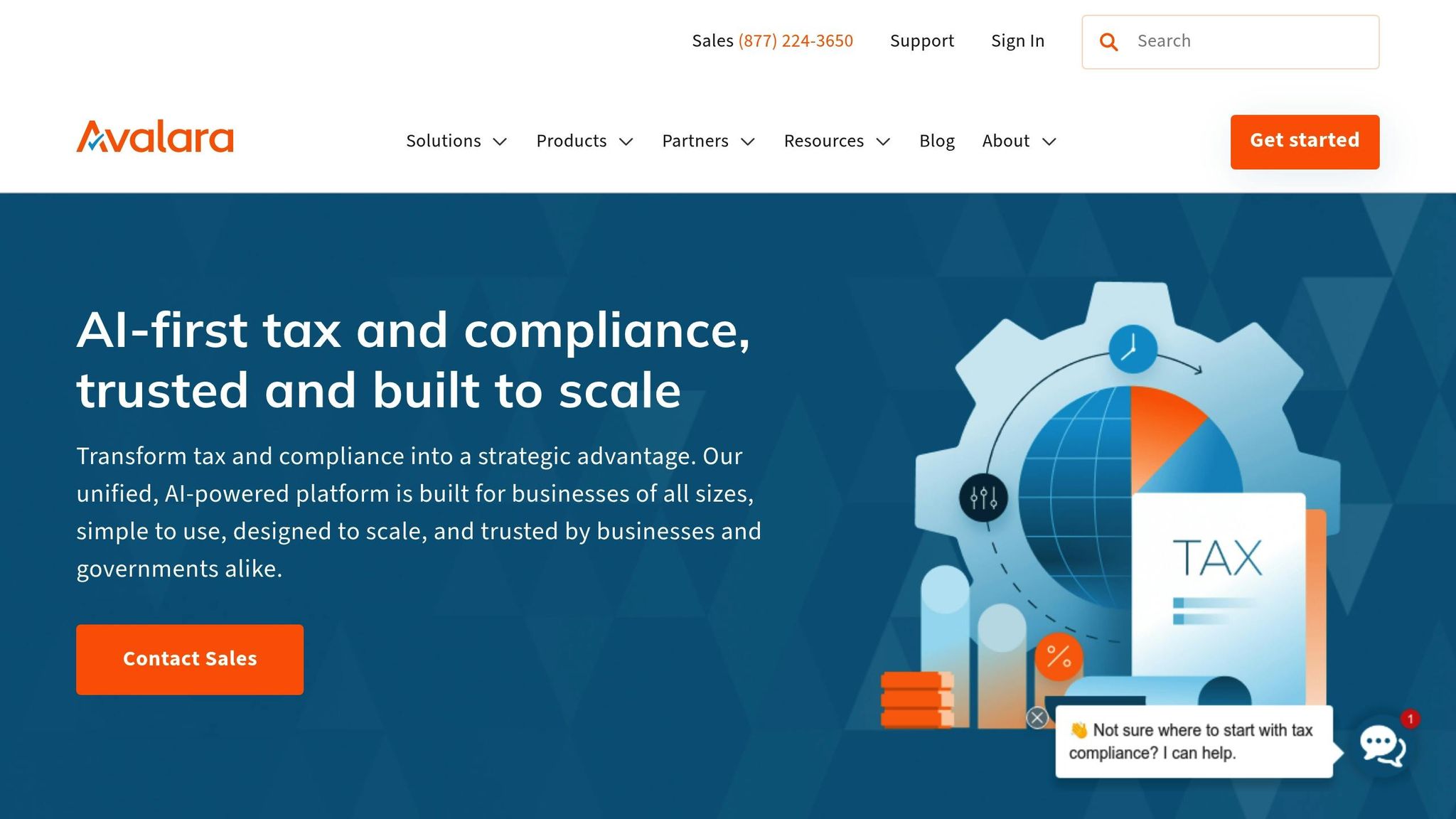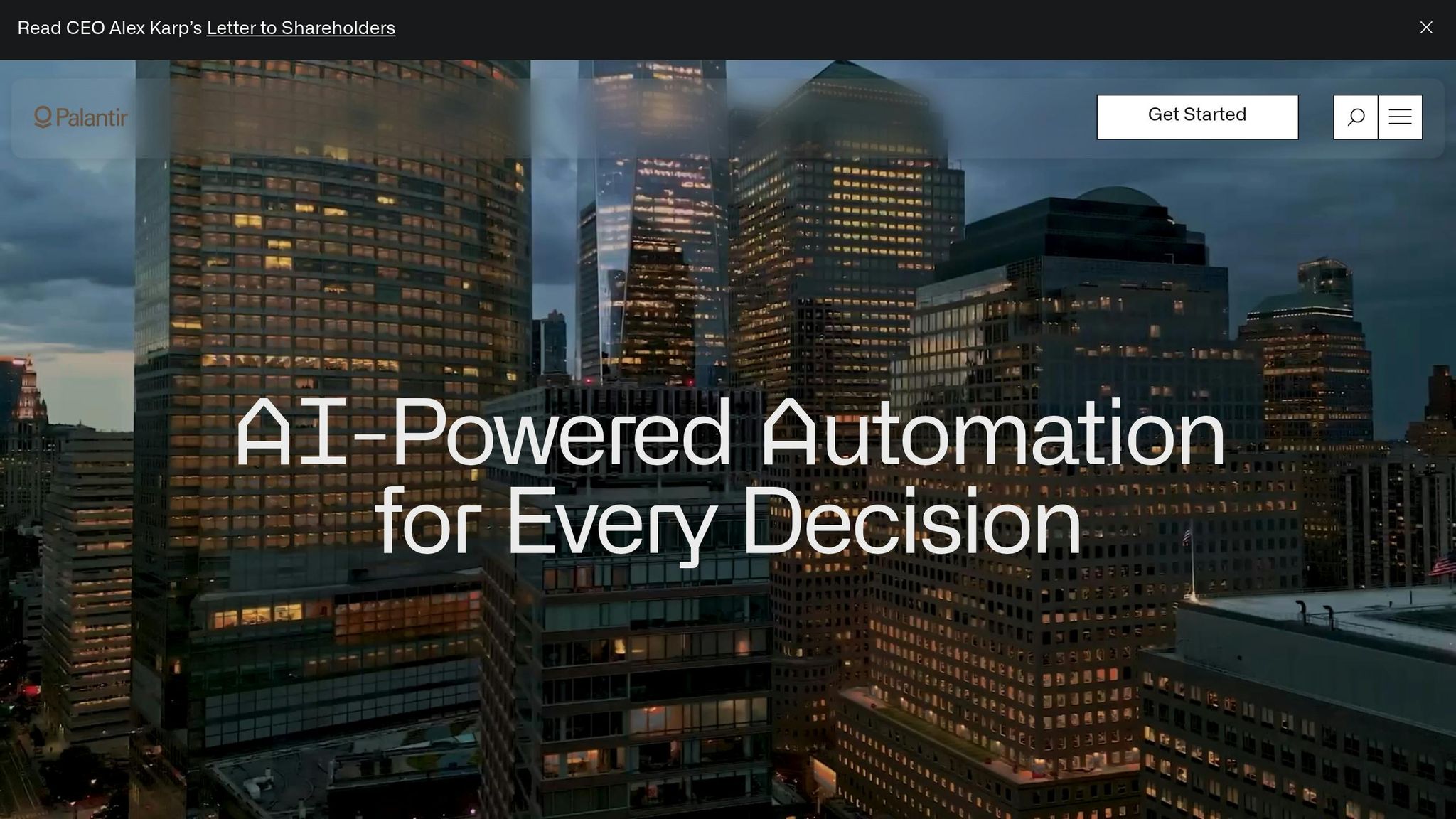Best Tariff Classification Tools for 2025
Explore the top tariff classification tools of 2025 to navigate compliance and reduce costs in a complex trade environment.

Best Tariff Classification Tools for 2025
In 2025, navigating U.S. tariff classification has become more challenging due to rising tariffs and stricter customs enforcement. Accurate tools are crucial to avoid penalties, reduce costs, and ensure compliance. Here’s an overview of four top solutions:
- GetTariffs: Simplifies tariff calculations with AI-driven tools and daily updates. Ideal for small businesses and new importers. Free and premium plans available.
- Avalara Automated Tariff Code Classification: Uses AI and machine learning for precise HS code classification. Best for businesses already using Avalara’s tax tools.
- Palantir AI Platform: Advanced analytics for large enterprises with complex supply chains. High implementation costs but offers deep insights for compliance.
- Smart HS: AI-powered tool for fast and accurate HS code classification. Works well with systems like SAP and Shopify. Requires quality product data for best results.
Key takeaway: These tools help businesses manage tariff complexities, but selecting the right one depends on company size, budget, and operational needs.
Quick Comparison
| Tool | Best For | Key Features | Limitation |
|---|---|---|---|
| GetTariffs | Small businesses | AI-driven tariff calculations | Free plan limits to 5 uses/day |
| Avalara | Tax-focused businesses | Integrates with Avalara tax solutions | Limited to Avalara ecosystem |
| Palantir AI | Large enterprises | Advanced analytics, supply chain insights | High implementation costs |
| Smart HS | E-commerce integration | AI with adaptive learning | Relies on quality product data |
These tools cater to varying business needs, from simple calculations to advanced compliance strategies.
Duty Optimization Through Tariff Engineering and HTS Classification
1. GetTariffs

GetTariffs is a web-based tool designed to calculate accurate import costs, helping importers navigate one of their biggest challenges: figuring out tariff rates and total landed costs before making purchasing decisions. This platform reflects how technology is transforming tariff compliance in today's complex trade environment.
The tool uses AI to calculate duties instantly based on HTS codes or product descriptions, making it perfect for businesses without extensive customs expertise. With daily updates, it ensures users have access to the latest rates, even in the unpredictable trade climate of 2025. Its extensive tariff database covers imports from virtually any country, offering wide-ranging support.
Thousands of importers rely on GetTariffs to fine-tune their cost estimates. By providing accurate tariff rates, duties, and total landed costs, the platform helps businesses evaluate the financial impact of sourcing from different countries. It also enables them to explore alternatives, such as exemptions or new sourcing options, to minimize costs. This precise duty calculation tackles the growing issue of misclassification, which can lead to costly errors.
GetTariffs offers a free plan with five daily calculations, while premium plans unlock unlimited access and detailed tariff impact reports. Additionally, the platform features an updated blog with insights into changing trade regulations. Supporting multiple origin and destination countries, it also includes a product-specific tariff search, allowing users to look up tariffs using detailed product descriptions - removing the guesswork and reducing the risk of customs misclassification.
2. Avalara Automated Tariff Code Classification

Avalara's Automated Tariff Code Classification system combines AI, machine learning, and human expertise to simplify HS code classification. This automation plays a crucial role in calculating customs duties and adhering to shipping regulations. Below, we’ll explore its learning capabilities, service options, integration features, and compliance strategies.
With a database of over 30 million refined classifications, Avalara's system analyzes product descriptions and attributes to determine the correct tariff codes with precision.
The platform offers two service tiers to cater to different business needs. Essentials provides a quick and affordable solution for HS code classification, while Pro adds expert analysis and customer-specific AI/ML models for more tailored support. This flexibility allows businesses to align the service with their complexity and budget.
Avalara seamlessly integrates with more than 1,200 systems, including e-commerce platforms, ERP software, and billing tools. Certified partnerships include MYOB Acumatica, Simpro field service management software, and the SCAYLE enterprise commerce platform. These integrations ensure smooth incorporation into existing workflows, helping businesses streamline their processes.
The system references global databases like the WCO and adheres to country-specific regulations. By classifying products down to the country-specific tariff level, Avalara supports tax compliance and shipment accuracy. This is particularly important for navigating the complexities of US import regulations, where errors can lead to costly fines or delays.
Craig Reed, GM of Cross Border at Avalara, highlights the platform's ability to simplify trade compliance:
"Automation is the golden ticket to scaling cross-border trade without getting buried in compliance headaches. Avalara's suite of compliance services helps customers stay on top of this rapidly changing environment. Businesses that integrate real-time duty and tax solutions can classify goods instantly, calculate accurate costs, and clear customs all without slowing down operations".
The system also improves over time through a continuous learning mechanism that uses validated HS codes to enhance accuracy. This feature is especially valuable for businesses with large product catalogs or those entering new markets.
To maximize classification accuracy, Avalara recommends providing detailed product information, including the title, description, category, and destination country.
3. Palantir AI Platform for Tariff Impact and Compliance

Palantir's AI Platform (AIP) bridges the gap between artificial intelligence and enterprise operations by transforming fragmented, unstructured information into actionable insights for tariff classification. Unlike standalone tools, Palantir takes an integrated approach, tackling the intricate trade compliance challenges faced by large organizations.
At the heart of this system is Palantir's Ontology, which connects various enterprise functions - like logistics, inventory, finance, compliance, and sales - into a unified framework. This framework organizes an organization's data, business logic, and processes into a structured and accessible system, making it easier to manage and analyze complex information flows.
AIP uses advanced AI capabilities to simplify and improve tariff compliance. For example, it can recommend accurate classification codes based on product details and employs OCR technology to digitize export control licenses, reducing reliance on manual data entry and minimizing errors. The platform also automates the creation of global Harmonized System (HS) and Harmonized Tariff Schedule (HTS) codes through its HTS Code and US Tariff Impact Calculator. Additionally, its integration with major cloud providers, including Google Cloud and AWS, ensures scalability across industries via Foundry and other AIP tools.
Real-world applications highlight the platform's practical benefits. For instance, a consumer goods company used Palantir to navigate steel tariff increases by identifying affected supply routes, contracts, and cost structures. The platform helped generate actionable strategies, such as temporary sourcing adjustments and inventory rebalancing, to mitigate the impact.
Security and compliance are key priorities for Palantir. The platform is accredited for DISA Impact Level 6 (IL6), enabling it to handle data classified up to the SECRET level. It also incorporates strong security measures, including access controls, encryption, and audit capabilities, to ensure data integrity. Furthermore, it provides tools for generating audit trails and detailed explanations of model decisions, fostering user trust and transparency.
Palantir's ability to deliver actionable strategies quickly - often within weeks - offers businesses with complex supply chains a way to reduce compliance risks and respond effectively to changing trade environments. Up next, we’ll explore Smart HS, which brings a different perspective to tariff classification.
sbb-itb-148ee33
4. Smart HS
Smart HS, a tool within Thomson Reuters' ONESOURCE Global Classification suite, revolutionizes the process of HS code classification for U.S. importers. By combining artificial intelligence and machine learning, it goes beyond basic keyword searches, acting as a decision-support system tailored to a business's specific needs.
This platform allows users to input commercial product descriptions in plain language, returning relevant HS codes along with probability scores. Think of it as a search engine for tariff classification, simplifying the process for team members who may not have deep trade compliance expertise.
"With the power of artificial intelligence and machine learning, our Smart HS tool allows you to classify your products more quickly, easily, and accurately than ever before." - Thomson Reuters
What makes Smart HS stand out is its adaptive learning feature. Over time, the system becomes more precise, learning the unique details of your industry and product lines. Early AI model tests have shown 85% accuracy, with even better results when product descriptions are optimized.
The platform also supports real-time classification through API integration. This means businesses can automate HS code searches during key processes like online checkouts or customs documentation. Smart HS integrates smoothly with popular systems such as SAP, Shopify, and Magento, reducing manual tasks and minimizing errors.
Beyond assigning codes, Smart HS enhances compliance by reducing mistakes in customs declarations - errors that can lead to financial penalties, embargoes, or missed tax obligations. It also boosts document traceability and streamlines export workflows, especially useful as the U.S. International Trade Commission frequently updates the HTSUS.
For businesses aiming for peak performance, optimizing product descriptions within the system can push accuracy rates to over 99%. Below, we’ll explore the platform's strengths and limitations in detail.
Pros and Cons
Each tool in the tariff classification space brings its own strengths and challenges. Knowing these details helps businesses choose the right fit based on their goals, budget, and compliance needs.
GetTariffs prioritizes simplicity and ease of use, offering quick tariff calculations with daily updated official rates. Its AI-driven instant lookups are particularly useful for new importers. However, the free plan limits users to 5 calculations per day, which can be restrictive.
Avalara's Automated Tariff Code Classification integrates seamlessly with Avalara's broader tax compliance tools, creating a unified automation platform. This makes it an attractive option for businesses already using Avalara's solutions.
Palantir's AI Platform shines in advanced data analytics and pattern recognition, uncovering nuanced classification opportunities that might otherwise be missed. While ideal for complex operations, its high implementation costs can be a barrier for smaller companies.
Smart HS boasts an accuracy rate of 85–99%, depending on the quality of the input data. Its adaptive learning feature enhances performance over time, as seen in Georgia-Pacific's case, where classification time was cut by 50% after adopting ONESOURCE. However, its effectiveness relies heavily on maintaining high-quality internal data, which requires consistent optimization.
| Tool | Accuracy Rate | Update Frequency | Key Integration | Primary Limitation |
|---|---|---|---|---|
| GetTariffs | Not specified | Daily updates | Tariff lookups across countries | 5 calculations/day (free plan) |
| Avalara | Not specified | Regular updates | Integrated with Avalara solutions | Not specified |
| Palantir AI | High | Real-time | Not specified | High implementation complexity |
| Smart HS | 85–99% | Regular updates | Not specified | Dependence on high-quality internal data |
The financial stakes in choosing the right tool are also considerable. Implementation costs range from $5,725 to $286,263, and errors in classification can lead to fines between $1,917.96 and $2,729.04 per mistake.
"Classification has gone from something that's important and you should do it right, to something where you better be getting it right because they're really checking for it now." - Liz Connell, Vice President of Product Management, ONESOURCE Global Trade with Thomson Reuters
Even with advanced AI, human oversight remains essential to handle ambiguous cases and safeguard sensitive data. Traditional systems often falter with vague product descriptions, new items, or mismatches between commercial listings and official Harmonized System definitions.
The World Customs Organization updates the Harmonized System every five years, issuing recommendations to reflect evolving regulations. Staying compliant requires tools to adapt quickly. For instance, Thomson Reuters implemented 100 million content changes in 2024 alone, highlighting the rapid pace of updates.
For budget-conscious businesses, setup and maintenance time are key considerations. Studies show that about 70% of executives spend 45 minutes to three hours on repetitive tasks during an 8-hour workday. While automation can save time, it demands careful planning to manage both initial setup and ongoing upkeep.
Weighing these pros and cons is critical for businesses aiming to streamline trade compliance while avoiding costly missteps.
Conclusion
By 2025, choosing the right tariff classification tool will be a key step in tackling the intricate challenges of trade compliance. The best option for your business will hinge on factors like company size, budget, and specific compliance requirements.
GetTariffs is an excellent choice for businesses that prioritize simplicity and affordability. Its daily updates with official rates and AI-powered instant lookups make it especially helpful for new importers navigating the complexities of the Harmonized Tariff Schedule of the United States (HTS). The free plan, which allows up to five tariff calculations per day, is a great fit for smaller businesses.
For companies heavily invested in tax compliance, Avalara's Automated Tariff Code Classification is a strong contender. It integrates seamlessly with Avalara's existing suite of tools, streamlining both domestic tax and international trade compliance. This makes it ideal for businesses managing multiple layers of regulatory requirements.
Larger enterprises with complex product catalogs and extensive international operations may find Palantir's AI Platform worth the investment. While its implementation can be expensive, the platform's advanced analytics are tailored for high-volume operations, offering significant value for businesses with large-scale needs.
Smart HS offers impressive accuracy rates ranging from 85% to 99%. However, to achieve peak performance, businesses need to maintain high-quality internal product data, which requires ongoing effort and upkeep.
The stakes for proper classification are high - errors can lead to fines ranging from $1,917.96 to $2,729.04. This underscores the importance of seamless system integration and continuous monitoring to stay compliant with ever-changing regulations. Tools that offer real-time API capabilities can automate HS code searches during checkout and generate customs documentation, helping businesses stay aligned with current requirements.
While advanced AI significantly boosts efficiency, it’s crucial to pair these tools with expert oversight. Even the most sophisticated AI systems can struggle with ambiguous cases, making human review indispensable. By combining the speed of automation with expert input, businesses can achieve both accuracy and efficiency in their classification processes. As trade regulations evolve, selecting a tool that adapts quickly will be essential to safeguarding your operations from costly mistakes.
FAQs
How can I choose the right tariff classification tool for my business?
Choosing the right tariff classification tool hinges on what your business actually needs. Begin by assessing how complex your product catalog is and the scale of your trade operations. For companies dealing with extensive inventories, automation can be a game-changer. On the other hand, smaller businesses might focus more on simplicity and user-friendliness.
When evaluating tools, prioritize those that provide precise HS code identification, integrate effortlessly with your current systems, and align with U.S. customs regulations. If you're feeling uncertain, it might be worth reaching out to a trade compliance expert who can help you match the tool's features to your specific business goals.
What risks come with incorrect tariff classification, and how can these tools help prevent them?
Incorrect tariff classification can cause major headaches for businesses. We're talking fines, confiscated goods, shipping delays, and even legal trouble. These problems can throw a wrench into your supply chain and rack up unexpected costs.
That’s where advanced tariff classification tools come in. They help ensure accurate, consistent classifications, cutting down on human errors and keeping your business in line with U.S. customs regulations. By automating tricky processes, these tools not only save you time but also help you steer clear of expensive mistakes.
How do AI and machine learning improve the accuracy and efficiency of tariff classification tools?
AI and machine learning are transforming tariff classification by processing vast amounts of data to deliver highly precise results. This level of accuracy helps businesses minimize errors in customs declarations and stay aligned with trade regulations.
By automating repetitive tasks, these technologies also make the classification process faster and more efficient. They allow businesses to handle multiple products at once, freeing up time to focus on bigger-picture strategies while cutting down on expensive compliance mistakes.
Related Articles
Calculate Your Import Costs
Use our free tariff calculator to estimate duties and total landed costs for your imports
Try Tariff Calculator